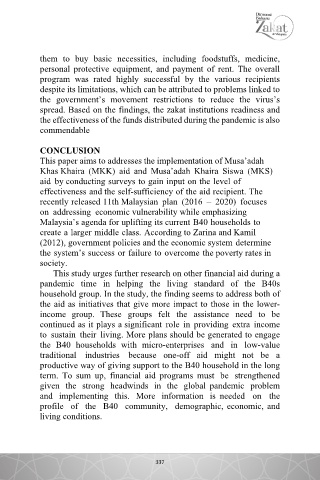Page 344 - Dimensi Baharu Zakat di Malaysia
P. 344
© DIMENSI BAHARU ZAKAT DI MALAYSIA
ISBN 978-967-2959-04-5
them to buy basic necessities, including foodstuffs, medicine,
personal protective equipment, and payment of rent. The overall
program was rated highly successful by the various recipients
despite its limitations, which can be attributed to problems linked to
the government’s movement restrictions to reduce the virus’s
spread. Based on the findings, the zakat institutions readiness and
the effectiveness of the funds distributed during the pandemic is also
commendable
CONCLUSION
This paper aims to addresses the implementation of Musa’adah
Khas Khaira (MKK) aid and Musa’adah Khaira Siswa (MKS)
aid by conducting surveys to gain input on the level of
effectiveness and the self-sufficiency of the aid recipient. The
recently released 11th Malaysian plan (2016 – 2020) focuses
on addressing economic vulnerability while emphasizing
Malaysia’s agenda for uplifting its current B40 households to
create a larger middle class. According to Zarina and Kamil
(2012), government policies and the economic system determine
the system’s success or failure to overcome the poverty rates in
society.
This study urges further research on other financial aid during a
pandemic time in helping the living standard of the B40s
household group. In the study, the finding seems to address both of
the aid as initiatives that give more impact to those in the lower-
income group. These groups felt the assistance need to be
continued as it plays a significant role in providing extra income
to sustain their living. More plans should be generated to engage
the B40 households with micro-enterprises and in low-value
traditional industries because one-off aid might not be a
productive way of giving support to the B40 household in the long
term. To sum up, financial aid programs must be strengthened
given the strong headwinds in the global pandemic problem
and implementing this. More information is needed on the
profile of the B40 community, demographic, economic, and
living conditions.
336
337

